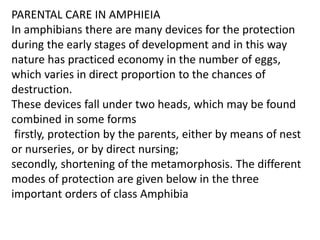
PARENTAL CARE.pptx
- 1. PARENTAL CARE IN AMPHIEIA In amphibians there are many devices for the protection during the early stages of development and in this way nature has practiced economy in the number of eggs, which varies in direct proportion to the chances of destruction. These devices fall under two heads, which may be found combined in some forms firstly, protection by the parents, either by means of nest or nurseries, or by direct nursing; secondly, shortening of the metamorphosis. The different modes of protection are given below in the three important orders of class Amphibia
- 2. Protection by Means of Nests and Nurseries A. In enclosures in the water: A large tree frog (Hyla faber). lt protects its progeny by building a basin-shaped nursery in shallow water on the border of the pond. The female scoops mud to a depth of 3 or 4 inches and with the material thus removed a circular wall is built which emerges above the surface of the water.
- 3. The inside wall is smoothened by the webbed and flattened hands; the bottom is leveled by belly and hands. The eggs and early larvae are thus protected from attack of many insects and fishes, etc., at least for some time, heavy rains later on destroy the wall and larvae go to the water.
- 4. B. In holes near water: A still better mode of protecting the offspring during the early stages of development has been adopted by a Japanese tree frog Rhacophorus schlegelii. The male and female in embrace bury themselves in the damp earth on the edge of ditch or fooded rice field, and make a hole or chamber, a few inches above water level.
- 5. The walls of this chamber are polished and during this process the gallery by which they enter into that chamber gets obliterated, oviposition begins. The female first produces a secretion from cloaca which is beaten into a froth. The eggs are deposited into the froth. Now the inactive male impregnates them, now both of them separate and make an exit gallery towards the ditch. It is obliquely downwards towards the water; later on this is used by the lervae who come to the water to complete the development.
- 6. The bubbles collapse, the froth liquefies and this liquid acts as an efficient vehicle for transporting. The larvae which are carried down the tunnel into the water
- 7. In nests on trees or on rocks overhanging the water: Some tree frogs like Phyllomedusa in South America, Rhacophorus malabaricus in India, and Chiromantis in tropical Africa, deposit their spawn on trees,
- 8. The froth is attached to one or many leaves stuck together and overhanging a pool for a few days. The larvae move in froth and after losing the external gills, they fall in water to complete metamorphosis.
- 9. In transparent gelatinous bag in the water: The eggs of Phrynicabus biroi are large which are enclosed in sausage-shaped transparent common membrane secreted by the female and is left in the mountain streams.
- 10. The whole development takes place within the eggs and little frogs go out in perfect condition NO gills have been observed and the large tail serves as a breathing organ of young ones.
- 11. On trees or in moss away from water In several species of tropical American genus Hylodes, the eggs are deposited in damp places under stones or moss or plant leaves and are of large size.
- 12. The metamorphosis is hurried up within the egg, there is a plenty of yolk in the egg and hence entire development takes place there and young frog hops out as an air breather with a vestige of tall which was fully developed and highly vascularized and served as a respiratory organ. No gills have been seen.
- 13. Direct Nursing by the Parent A. Tadpoles transported from one place to another by males: Small South American frogs Phyllobates and Dendrobates have been repeatedly observed carrying well-developed tadpoles on their back.
- 14. Tadpoles adhere by their sucker-like lips and flattened abdomen and thus they are carried from one place to the other and in this way they can even go from one pool to the other and this is particularly when one pond is to dry
- 15. B. Eggs protected by male who covers with his body The eggs of Mantophyrne robusta are strung together by an elStic gelatinous envelope. They are seventeen in number and form a lump over which the male sits, holding it with both hands and development takes place there. It may be outside water. The larvae have no gilis, well developed legs, large tail which is vascularand and respiratory.
- 16. Eggs carried by the parents Midwife toads (Alytes) are a genus of frogs in the family Alytidae and are found in most of Europe and northwestern Africa.the males carry a string of fertilised eggs on their back, hence the name "midwife"
- 17. The female expels a strand of eggs, which the male fertilizes externally. He then wraps them around his legs to protect them from predators in the water. When they are ready to hatch, the male wades into shallow water, where he allows the tadpoles to leap out of their eggs.